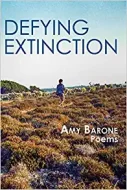 Amy Barone
Amy Barone
Defying Extinction
Broadstone Books
Reviewer: Ann Wehrman
In Defying Extinction, Amy Barone takes the reader on a journey through the world of humans and nature, capturing with winsome tenderness the power, wildly diverse colors, and exquisite beauty of life on planet Earth. The poet’s lens ultimately cherishes more than it analyzes. Her gentle gaze reflects upon the fabric of nature, animals, and people; her curious and imaginative exploration of life in the moment yields images that evoke sadness and delight, as the enchanted reader walks alongside. Despite humanity’s ongoing conflicts, devastation, and disasters, including COVID-19, these poems express trust in the continued triumph of love, light, and the sacred.
Barone presents the collection in five loosely organized sections: I: Sacred Places, II: The Wild, III: Heirlooms, IV: Love & Family, and V: Anima Protection. In the first section, she builds her case like a literary scientist reveling in descriptive research, each poem a puzzle or mystery, its deeper meaning obscured by varying degrees. In “Survivors,” Barone explores themes of identity, patience, and fidelity. The speaker identifies as an old spirit, one who heals:
Me—I’m the woman with medicine in her voice
a forest bather mating like a corpse plant, melting into time,
floating toward a twelfth life like a trumpeter swan.
Quick tangential research on the corpse plant reveals that Amorphophallus titanium (Titan Arum as it’s commonly known), native to Sumatra, only blooms for one day every seven years or longer. The rare flowering, mirroring that of the long-living seer, combines here with the romantic image of trumpeter swans that mate for life and live an average of thirty years. Both images suggest wisdom and insight.
“Swimming on La Luna” reveals another side of the author as a traveling researcher, that of a sensitive heart, the curse of an empath, who, during the pandemic, must struggle to purge the intake of others’ agony” “I …spend fitful nights / asleep with people still in my system.” In “Happy People,” the speaker remembers people-watching at a Santo Domingo resort, “cradling my heart at twenty-two after a failed affair.” She remembers the Venezuelan fellow tourists celebrating, “a group of blissful people singing and laughing,” and warns the reader to stay alert, that “echoes of cheer” ring emptily in the face of today’s starvation and social breakdown in that nation.
Still in Section I, “Heavenly Park” weaves a darkly playful warning. The author views the stars and constellations:
Earth’s hot. A new plague landed. Nightfall is safer.
Maybe we’ll find remnants of a shiny meteorite
to hang at home.
I’ll fix a moonrise picnic on a beach of stardust
with a view of Andromeda and the Milky Way,
while we can, before the stars explode.
And in “Mars Bound,” Barone lets it rip with wicked humor, ten lines of extended, dark jest that in the spirit of eternal adventure resolve to give life as a human being a new try on the red planet:
Though I recoil from lines, I’m standing in one,
intent on moving to Mars.
Surmounting fear of flying to make
an eight-month trek on the Virgin mothership.
…
Resolved to erect a life unfettered
by wires, rules, love, and reason.
In Section II: The Wild, Barone celebrates the unique beauty of animals and plants, which in its purity helps even the crustiest, most selfish human beings open their hearts. In the spare, eloquent, “Tree Talk,” the speaker memorializes trees, reminding one that,
Baltic temples
in forests
lured people
to release sorrows
and setbacks
to the trees,
protectors, shade, our friends.
In “Twilight Flight,” sensual images of colors stimulate the reader’s yearning and delight in the Earth’s beauty:
After the sun drops,
a cobalt dusk takes root.
Leaves in ochre, saffron
and jade float toward night.
…
Traces of emerald horizon and brown shadow
give way to blue tattooed sky.
In Section III: Heirlooms, Barone celebrates earthly delights and human relationships. This section includes the poem “Missing Spice,” in which the speaker in nomadic mode looks outside and experiences the world, simultaneously observing and noting:
I cool my tongue with anise seeds, pour a bitter digestivo over ice
whenever the jolt from turmeric and serrano assaults.
As the urge to journey heats up, I play Motown sounds and move
to upbeat tunes as I edit the list of places I long to savor.
Barone continues to explore relational dynamics in Section IV: Love and Family; in “Gripped By the Edge of Night,” she unearths a memory to which her readers may relate:
I learned the facts of life at the foot
of my mother’s ironing board
each afternoon as we followed The Edge of Night.
This collection ends with Section V: Anima Protection. The powerful “Blood Orange Days” testifies to the legacy of COVID-19: a sense of foreboding, the contrast between eerie stillness and hints of violence, sickness, and death.
Reports of illness and death pepper my Facebook feed.
I grieve with Giovanna, an Italian friend in Brooklyn,
who buried her father and uncle in Bergamo from afar.
. . .
Pink blossoms on Japanese maples
and weeping willows color the town.
The sun’s shadow shelters leafless trees.
A sole ambulance siren slices the peace.
Despite the realities of death and violence, Barone defies extinction, cherishing ongoing perceptions and experiences as well as beloved memories. She searches for meaning, distilling the sacred from the tangible, from what she perceives with her senses. Relishing Barone’s crystalline lines, a reader feels deeply encouraged. Perhaps love is indeed all we need.

